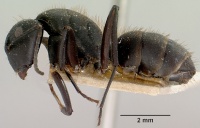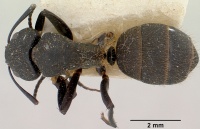Camponotus themistocles
| Camponotus themistocles | |
|---|---|

| |
| Scientific classification | |
| Kingdom: | Animalia |
| Phylum: | Arthropoda |
| Class: | Insecta |
| Order: | Hymenoptera |
| Family: | Formicidae |
| Subfamily: | Formicinae |
| Tribe: | Camponotini |
| Genus: | Camponotus |
| Subgenus: | Mayria |
| Species group: | darwinii |
| Species: | C. themistocles |
| Binomial name | |
| Camponotus themistocles Forel, 1910 | |
Camponotus themistocles has been collected at three localities in southern Madagascar: two are littoral forest and one is gallery forest. All sites are at low altitudes from 10 to 30 meters. Camponotus themistocles is a ground nester; most collections have been made from sifted litter, rotten logs, and dead twigs above the ground.
Identification
Rasoamanana and Fisher (2022) - A member of the Camponotus darwinii species group. Integument dark brown with rust or red-brown suberect pilosity. Anterior clypeal margin with rectangular projection. Petiole scale thin with sharp border.
Camponotus themistocles differs from Camponotus radovae by its larger size and the sculpture of the lateral sides of its mesosoma, which is finely reticulate-punctate in the former and widely striolate in the later. In addition, in lateral view, the petiole scale of C. themistocles has an acute summit but is blunt in C. radovae. Pubescence is long and abundant in C. themistocles, and short and dilute in C. radovae. Morphometrical analysis reveals that C. themistocles and Camponotus ellioti are the same size, but differ in integument coloration and pilosity pattern on the gastral tergite
Keys including this Species
Distribution
Distribution based on Regional Taxon Lists
Malagasy Region: Madagascar (type locality).
Distribution based on AntMaps
Distribution based on AntWeb specimens
Check data from AntWeb
Biology
Castes
Nomenclature
The following information is derived from Barry Bolton's Online Catalogue of the Ants of the World.
- themistocles. Camponotus themistocles Forel, 1910e: 456 (w.) MADAGASCAR.
- Type-material: holotype minor worker.
- Type-locality: Madagascar: Fort Dauphin (F. Sikora).
- Type-depository: MHNG.
- Santschi, 1911e: 133 (s.).
- Combination in C. (Myrmobrachys): Forel, 1914a: 271;
- combination in C. (Myrmepomis): Emery, 1920b: 258;
- combination in C. (Myrmopiromis): Wheeler, W.M. 1922a: 707;
- combination in C. (Mayria): Rasoamanana & Fisher, 2022: 147.
- Subspecies of darwinii: Santschi, 1911e: 133; Wheeler, W.M. 1922a: 1051; Emery, 1925b: 128; Bolton, 1995b: 127.
- Status as species: Rasoamanana & Fisher, 2022: 196 (redescription).
- Distribution: Madagascar.
Unless otherwise noted the text for the remainder of this section is reported from the publication that includes the original description.
Description
Worker
Rasoamanana and Fisher (2022):
Morphological measurements: see Appendix 1 and Ratios of morphometric data for majors and minors
Minor
Medium-sized. Absolute cephalic size (CS: 1.82±0.37; 1.53–1.98). In full-face view, head slightly longer than broad, a little narrower in front than in back, with straight occipital and feebly convex lateral margins (CWb/CL: 0.36±0.03; 0.34–0.38). Eyes circular, placed much closer to the lateral sides (PoOC/CL: 0.07±0.01; 0.07–0.08). Mandibles triangular with sixteeth. With head in full-face view, anterior clypeal margin produced, entire, and angularly projecting in the middle. Antennal scape circular, long, surpassing the occiput by the lengths of two basal funiculi (SL/CS: 0.41±0.05; 0.38–0.44). In lateral view, anterodorsal corner of pronotum broadly rounded, mesosomal dorsum moderately arcuate, propodeum dorsum a little shorter than the declivity, each straight in profile and meeting at an obtuse angle (MW/ML: 0.21±0.02, 0.20–0.22; MPD/ML: 0.24±0.03; 0.22–0.26). In lateral view, petiolar node wedge-shaped, with feebly convex anterior and flattened posterior faces. Ants entirely reticulate-punctate. Mandible finely striolate with sparse punctures. Pilosity and pubescence brownish yellow, the former long and curved forward especially on vertex, frontal area, and mesosomal dorsum; mostly short and sparse on gastral tergites; petiolar dorsum edge with four or five pairs of brownish yellow hairs. Body color matte black, apical portion of mandible reddish.
Major
Characteristics of minor workers, except: head somewhat cordate, with nearly straight posterior margin and slightly convex lateral sides (CS: 2.68±0.36, 2.26–3.15; CWb/CL: 1.05±0.04, 0.99–1.11). Eyes elliptical, placed dorsally midway from the occipital margin (PoOC/CL: 0.23±0.01, 0.22–0.25). Clypeus much more quadrate in full-face view with truncate anterior margin (ClyL/GPD: 0.82±0.07, 0.73–0.93). Antennal scape short, just surpassing the occipital border (SL/CS: 0.75±0.03, 0.71–0.79). Dorsal outline of mesosoma interrupted by pronotal and mesonotal sutures, basal portion of propodeum forms an obtuse angle with the declivity. Lateral portion of head finely punctate, frontal area and vertex with deep punctures.
Type Material
Rasoamanana and Fisher (2022) - Camponotus darwinii themistocles Holotype minor worker, Madagascar, Fort Dauphin S. E. Madagascar, AntWeb CASENT0101381 (MHNG).
References
- Bolton, B. 1995b. A new general catalogue of the ants of the world. Cambridge, Mass.: Harvard University Press, 504 pp. (page 127, catalogue)
- Emery, C. 1920b. Le genre Camponotus Mayr. Nouvel essai de la subdivision en sous-genres. Rev. Zool. Afr. (Bruss.) 8: 229-260 (page 258, combination in C. (Myrmepomis))
- Forel, A. 1910f. Note sur quelques fourmis d'Afrique. Ann. Soc. Entomol. Belg. 54: 421-458 (page 456, worker described)
- Forel, A. 1914a. Le genre Camponotus Mayr et les genres voisins. Rev. Suisse Zool. 22: 257-276 (page 271, combination in C. (Myrmobrachys))
- Rasoamanana, N., Fisher, B.L. 2022. A taxonomic revision of the Malagasy endemic subgenus Mayria of the genus Camponotus (Hymenoptera, Formicidae) based on qualitative morphology and quantitative morphometric analyses. ZooKeys 1081: 137–231 (doi:10.3897/zookeys.1081.71872).
- Santschi, F. 1911e. Nouvelles fourmis de Madagascar. Rev. Suisse Zool. 19: 117-134 (page 133, soldier described)
- Santschi, F. 1911e. Nouvelles fourmis de Madagascar. Rev. Suisse Zool. 19: 117-134 (page 133, subspecies of darwinii)
- Wheeler, W. M. 1922k. Ants of the American Museum Congo expedition. A contribution to the myrmecology of Africa. IX. A synonymic list of the ants of the Malagasy region. Bull. Am. Mus. Nat. Hist. 4 45: 1005-1055 (page 707, combination in C. (Myrmopiromis))

